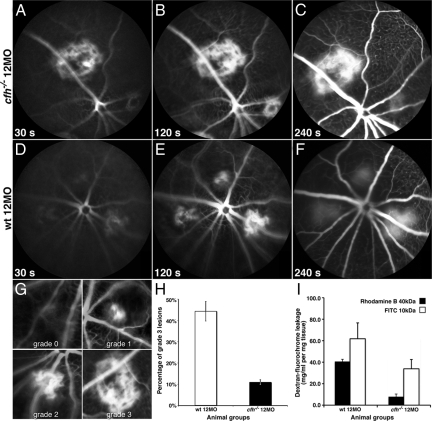Figure 8.
Experimentally induced CNV results in reduced leakage in the aged cfh−/− mouse compared with the aged-matched wild-type. Representative time-lapse fluorescein angiography sequence in 12-month-old complement factor H-deficient and aged-matched control mouse retinae show greater leakage over time in lesioned wild-type retina compared with lesioned CFH-deficient mice retina 2 weeks after procedure (A–F). The grading protocol used to compare leakage in experimentally induced CNV in 1-year-old cfh−/− with aged-matched control mice (G). Wilcoxon signed-rank test show significant difference in grade three bleeds between 1-year-old cfh−/− (n = 6) and aged-matched control mice (n = 6) (P < 0.025). H: Graph illustrating the reduction in leakage from experimentally induced CNV in 1-year-old cfh−/− compared with age-matched control mice 14 days after procedure. Rhodamine B-dextran leakage in knockout retinae (black bars) relative to control retinae normalized for dry weight of the tissue, plasma concentration and endogenous fluorescence and expressed as fluorochrome concentration in mg/ml per mg tissue is significantly smaller (P < 0.001). FITC-dextran leakage, similarly quantified is also significantly inferior (P < 0.01) to that in age-matched controls. Values are calculated as means ± SEM from n = 4 (I).

